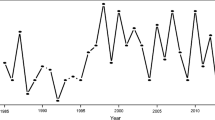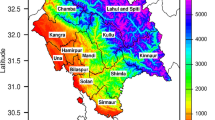Abstract
This study models maximum temperatures in Switzerland monitored in twelve locations using the generalised extreme value (GEV) distribution. The parameters of the GEV distribution are determined within a Bayesian framework. We find that the parameters of the underlying distribution underwent a substantial change in the beginning of the 1980s. This change is characterised by an increase both in the level and the variability. We assess the likelihood of the heat wave of the summer 2003 using the fitted GEV distribution by accounting for the presence of a structural break. The estimation results do suggest that the heat wave of 2003 is not that statistically improbable if an appropriate methodology is used for dealing with nonstationarity.





Similar content being viewed by others
Notes
The deviations are assessed as 0.2–0.3°C for provisionally inhomogenisation, reconstruction at the same place or nearby (Sion) and as −0.5° for the reconstruction in Bern, as reported by personal communication with MeteoSwiss.
This approach is rather standard in extreme value statistics. More than one observation during a period can be considered by using r-largest-techniques (Coles 2001). Changepoint problems using the Poisson process in a Bayesian framework date back to Raftery and Akman (1986). Renard et al. (2006) quote Peak-over-Threshold-methods as a second standard approach alternative to the analysis of block maxima, either with a Poisson process or the Generalized Pareto-distribution. These also allow using more data information than just one extreme during one period. Other information could be considered by kriging (spatial information) or a variety of multivariate methods. Seneviratne et al. (2006) used Canonical Correlation Analysis (CCA), based on daily maximum temperature to investigate the occurrence of heat waves.
An interesting extension of our work could be pursued along the lines of Perreault et al. (2000) suggesting a multivariate change-point analysis in order to establish a joint changepoint for the measurement series.
The modeling of a structural change using a step-function in the temporal evolution of parameters is of course not mandatory. Smooth functions could be used instead as long as they can be implemented into the likelihood function, as well as plenty approaches for modeling one or several breakpoints exist (Carlin et al. 1992; Stephens 1994; Mohammad-Djafari and Feron 2006; Moreno et al. 2005, among others).
In order to save space, we do not report the corresponding probability and quantile plots but make them available upon request.
References
Begert M, Schlegel T, Kirchhofer W (2005) Homogeneous temperature and precipitation series of Switzerland from 1864 to 2000. Int J Climatol 25:65–80
Beniston M (2004) The 2003 Heat Wave in Europe: a shape of things to come? An analysis based on Swiss climatological data and model simulations. Geophys Res Lett 31:2022–2026
Carlin BP, Gelfand AE, Smith AFM (1992) Hierarchical Bayesian analysis of changepoint problems. Appl Stat 41(2):389–405
Coles S (2001) An introduction to statistical modeling of extreme values. Springer Series in Statistics. Springer, New York
Coles S, Pericchi L (2003) Anticipating catastrophes through extreme value modelling. Appl Stat 52(4):405–416
De Bono A, Giuliani G, Kluser S, Peduzzi P (2004) Impacts of summer 2003 heat wave in Europe. Environmental Alert Bulletin, UNEP
Della-Marta PM, Haylock MR, Luterbacher J, Wanner H (2007a) Doubled length of western European summer heat waves since 1880. J Geophys Res (Atmospheres) 112:D15103
Della-Marta PM, Luterbacher J, von Weissenfluh H, Xoplaki E, Brunet M, Wanner H (2007b) Summer heat waves over western Europe 1880–2003, their relationship to large-scale forcings and predictability. Clim Dyn 29:251–275
Fink AH, Brücher T, Krüger A, Leckebusch GC, Pinto JG, Ulbrich U (2004) The 2003 European summer heatwaves and drought: synoptic diagnosis and impacts. Weather 59:209–216
Gamerman D (1997) Markov Chain Monte Carlo: stochastic simulation for Bayesian inference. Chapman & Hall, London
García-Herreira R, Díaz J, Trigo R, Luterbacher J, Fischer E (2009) A review of the European summer heat wave of 2003. Crit Rev Environ Sci Technol (in press)
Geweke J (1992) Evaluating the accuracy of sampling-based approaches to the calculation of posterior moments. In: Bernardo JM, Berger JO, Dawid AP, Smith AFM (eds) Bayesian statistics. Oxford University Press, Oxford, pp 169–193
Grize L, Huss A, Thommen O, Schindler C, Braun-FahrlSnder C (2005) Heat wave 2003 and mortality in Switzerland. Swiss Med Wkly 135:200–205
Jaeger CC, Krause J, Haas A, Klein R, Hasselmann K (2008) A method for computing the fraction of attributable risk related to climate damages. Risk Anal 28(4):815–823
Khaliq MN, Ouarda TBMJ, St-Hilaire A, Gachon P (2007) Bayesian change-point analysis of heat spell occurrences in Montreal, Canada. Int J Climatol 27(6):805–818
Klein Tank A, Wijngaard JB, Können GP, Böhm R, Demarée G, Gocheva A, Mileta M, Pashiardis S, Hejkrlik L, Kenr-Hansen C, Heino R, Bessemoulin P, Müller-Westermeier G, Tzanakou M, Szalat S, Pálsdóttir T, Fitzgerald D, Rubin S, Capaldo M, Maugeri M, Leitass A, Bukantis A, Aberfeld R, van Engelen AFV, Forland E, Mietus M, Coelho F, Mares C, Razuvaev V, Nieplova E, Cegnar T, Antonio López J, Dahlström B, Moberg A, Kirchhofer W, Ceylan A, Pachaliuk O, Alexanders LV, Petrovics P (2002) Daily dataset of 20th-century surface air temperature and precipitation series for the European Climate Assessment. Int J Climatol 22:1441–1453
Leadbetter MR, Lindgren G, Rootzen H (1983) Extremes and related properties of random sequences and processes. Springer Series in Statistics. Springer, New York
Mohammad-Djafari A, Feron O (2006) Bayesian approach to change points detection in time series. Int J Imaging Syst Technol 16(5):215–221
Moreno E, Casella G, Garcia-Ferrer A (2005) An objective Bayesian analysis of the change point problem. Stoch Environ Res Risk Assess 19:191–204
Perreault L, Parent E, Bernier J, Bobee B, Slivitzky M (2000) Retrospective multivariate Bayesian change-point analysis: a simultaneous single change in the mean of several hydrological sequences. Stoch Environ Res Risk Assess 14(4):243–261
Perron P (1989) The great crash, the oil price shock, and the unit root hypothesis. Econometrica 57(6):1361–1401
ProClim (2005) Hitzesommer 2003 Synthesebericht. ProClim/Schweizerische Akademie der Naturwissenschaften
Raftery AE, Akman VE (1986) Bayesian analysis of a poisson process with a change-point. Biometrika 73(1):85–89
Renard B, Lang M, Bois P (2006) Statistical analysis of extreme events in a non-stationary context via a Bayesian framework: case study with peak-over-threshold data. Stoch Environ Res Risk Assess 21(2):97–112
Robinson P (2001) On the definition of a heat wave. J Appl Meteorol 40:762–775
Schär C, Fischer E (2008) Warnsignal Klima: Gesundheitsrisiken – Gefahren für Pflanzen, Tiere & Menschen, Chapter Der Einfluss des Klimawandels auf Hitzewellen und das Sommerklima Europas, pp 50–55
Schär C, Vidale P, Lüthi D, Frei C, Häberli C, Liniger MA, Appenzeller C (2004) The role of increasing temperature variability for European summer heatwaves. Nature 427:332–336
Seneviratne SI, Luthi D, Litschi M, Schär C (2006) Land-atmosphere coupling and climate change in europe. Nature 443(7108):205–209
Stephens DA (1994) Bayesian retrospective multiple-changepoint identification. Appl Stat 43(1):159–178
Stott PA, Stone DA, Allen MR (2004) Human contribution to the European heatwave of 2003. Nature 432:610–614
Tamerius J, Wise E, Uejio C, McCoy A, Comrie A (2007) Climate and human health: synthesizing environmental complexity and uncertainty. Stoch Environ Res Risk Assess 21(5):601–613
Trigo RM, García-Herrera R, Díaz J, Trigo IF, Valente MA (2005) How exceptional was the early August 2003 heat wave in France? Geophys Res Lett 32:L10701
World Health Organization (WHO) (2003) The health impacts of 2003 summer heat-waves. Briefing note for the delegations of the fifty-third session of the WHO (World Health Organization) Regional Committee for Europe
Acknowledgments
The earlier version of the paper has benefited from the comments made by Klaus Hasselmann, Hans von Storch, two anonymous referees as well as by participants of the Workshop on Bayesian Risk Management, Carnegie Mellon University, Pittsburgh, USA. This research has benefited from the financial support provided by the German Federal Ministry of Education and Research (BMBF) in the framework of the project “Mainstreaming of climate risks and opportunities in the financial sector” (http://www.climate-mainstreaming.net/). We also would like to thank MeteoSwiss for sharing the data with us.
Author information
Authors and Affiliations
Corresponding author
Rights and permissions
About this article
Cite this article
Siliverstovs, B., Ötsch, R., Kemfert, C. et al. Climate change and modelling of extreme temperatures in Switzerland. Stoch Environ Res Risk Assess 24, 311–326 (2010). https://doi.org/10.1007/s00477-009-0321-3
Published:
Issue Date:
DOI: https://doi.org/10.1007/s00477-009-0321-3




